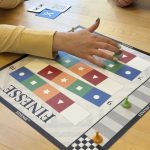Some people argue that robot bridge isn’t ‘real’ bridge, or that robot bridge is bad for real bridge. But the truth is, robot bridge is just different bridge. So if you, like me, enjoy playing robot bridge for whatever reason, here are some tips from the experts to help you become a consistent winner.
Robots don’t play like humans – here’s what you need to know

Robots don’t play like humans – here’s what you need to know
by Jude Goodwin © 2022 Great Bridge Links
I was complaining to my friend Julie the other day about a strange suit preference signal my robot bridge partner had made during the defense of 3NT and she said, “Oh, robots don’t play defensive signals.” and I’m like – whaa?! I’ve been playing robot challenges for years and I’m just learning this now?
That was the day I discovered that apparently robots don’t play a lot of things the same way humans do. Opening leads, defensive signals, even the meanings of basic bids.
Some people argue that robot bridge isn’t ‘real’ bridge, or that robot bridge is bad for real bridge. But the truth is, robot bridge is just different bridge. Another variety of bridge that takes its place alongside tournament bridge, home bridge, rubber bridge, etc. Another variety of our favourite game and something new to challenge ourselves.
So if you, like me, enjoy playing robot bridge for whatever reason, here are some tips from the experts to help you become a consistent winner.
BEST HAND FOR THE HUMAN
Best hand is a type of robot challenge where the human always has the most points. Most games where it’s just you against three bots will be ‘best hand.’ This is important to remember when counting out the hands. If you have 11 hcp, then no one else at the table has more and by implication, no one has less than 7 hcp either. If you have 12 hcp, nobody has more than 12 and nobody has less than 4. And so on. It might be useful to sketch out a chart for this.
Remembering that you have a better hand than your partner can be a big help when considering how to advance the auction. You might find there are times when you would even pass your partner’s forcing bid!
TIME LIMITS
“All move please,” is a call that can strike fear into the hearts of players who are just about to finish counting out a difficult but amazing slam hand. And how many times did your bridge teachers remind you that, “Bridge is a timed event.”
Well this is not always so with robot bridge. Challenge games have no time limit beyond the 3 days they last. This means you can take your time. Check all the bids. Count all the cards. Do the work and you’ll be happy you did.
And while tournaments are timed – for example, in the 12-board ACBL tournaments, you have 55 minutes to play 12 hands – there is still plenty of time so don’t rush. Bid and play slowly.
THE BIDDING
Most experts will tell you to check the meaning of every bid – those made by the opponents, your partner, and those you’re thinking of making. You can do this by passing your mouse over the bid (or tapping it with your finger on a tablet or phone). Apparently there are some old meanings hard-coded into the bots and there might be some non-standard meanings as well. Many doubles are different than you’d expect and competitive bids can show more than you would think.
In short, mousing over the bid tells you what the bots will think you mean by your bid and what they think they are showing with their bids.
A lot of experts agree that opening 1NT every chance you get is a great ploy. Open any balanced 14 points, hands with a long minor, 5 card major, it’s all good. The robots will always assume you have a certain shape and defend accordingly which often leads to good results for you.
And apparently the robot is a bad declarer. Some robot games will swap you around so you’re always the declarer. But tournament games won’t do this so you’ll need to consider that in the bidding. This supports opening light 1NT and 2NT as well as 4-card majors and as few as 11 hcp. Also, try not to show support for his suit when possible.
Speaking of doubles, be very careful making a penalty double. Your robot partner will most likely consider it a takeout double and pull. Only in auctions where partner has raised your suit — say, 1S -2H -2S -4H – 4S — will the robot partner consider a double to be penalty.
THE LEADS
There is a lot being said about robot leads, here are a few tips and you can follow up by reading the resources listed at the bottom of the page.
Robots love passive leads. They will prefer to lead from three or four small rather than lead away from honours. Robots will avoid leading unsupported Aces and Kings if possible. This can be very useful in placing honors.
They make some very bad leads against NT so you can be more aggressive bidding NT games. They often lead into your suit. They’ll lead singletons, even a singleton King.
In suit contracts, robots often lead doubletons.
If a robot leads the Ace of trump, it’s a singleton.
DEFENSE
As I mentioned in our opening, the robots do not play defensive carding, as a rule. But apparently they do play standard attitude at trick one only. A high card encourages, low discourages.
In his Video, Tips for Playing with BBO’s Robots, Pete claims robots on BBO play some count. But he suggests it’s better to not pay too much attention to this as it could be inaccurate.
Look on playing without signals as a kind of bonus in that it requires that you do more work counting hands and placing cards without the help from partner’s signalling.
DECLARER PLAY
Here are some great tips regarding declaring against robots. Most of these tips were found on Bridge Winners and some were found in the resources listed at the bottom of this article.
Robot defenders always split their lowest honor. So if you’re missing the QJT and lead towards the AK9, if LHO plays the Jack you can bet your bottom dollar that RHO has the Ten.
Duck as much as you can in NT when they’ve found your weak suit, they will switch often.
Run the jack when you have a two-way queen finesse – the robot will likely cover.
If you have the ace in your hand and lead towards the queen, if the robot does not fly king they do not have it.
In general, reject finesses. Only if it is absolutely safe to take them should you do so.
And don’t be afraid to ‘show your hand’ by cashing some winners. Likely it will encourage the bots to cash their own winners because they’ll think you’ve solved the ‘double dummy’ positions of everything.
And finally, in NT, if a robot has an entry to their long suit after you hold up, they’ll continue playing the suit to clear it. But if they don’t, they’ll switch. You can use this knowledge to place other cards.
CLAIMING
Chris Gibson on Bridge Winners notes: Claiming is your friend. There is no penalty for an incorrect claim. If you don’t remember whether a spot in your hand is high, claim on the assumption it is – if it gets rejected, then you know it isn’t after all.
Jim Fox in the same article, suggests: If you are playing a hand and have every trick other than a 2-way finesse, claim. The system will frequently give it to you.
This might be worth testing a few times however, as others in the thread argued whether or not this is true!
“So,” I asked my friend, “What other tips do you have about playing with and against robots?”
“Well,” Julie replied. “They count cards really well.”
RESOURCES
There are many articles and videos on this subject and we list a few below.
Tips for Playing with BBO’s Robots – The Basics by Pete
Playing with and against the GIBS
http://bridgewinners.com/article/view/playing-with-and-against-the-gibs/
What’s the best way to game the bots when playing robot bridge on BBO?
http://youth.worldbridge.org/whats-the-best-way-to-game-the-bots-when-playing-robot-bridge-on-bbo/
Robot Bridge Lectures by Josh Donn and Leo LaSota
https://bborobotbattles.com/robot-bridge-lectures-by-josh-donn-and-leo-lasota/








